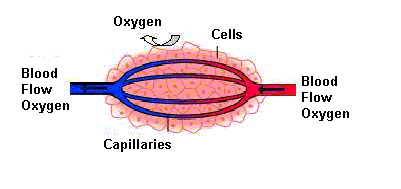Physiology / Other Methods
|

|
Blood and Oxygen Supply of Tissue 
Oxygen supply of tissue 
Comparison with alternative methods 
Blood and Oxygen Supply of Tissue
Microcirculation is necessary for exchange of nutrients and oxygen.
O2C measures:
Oxygen supply of tissue
Oxygen Means Life
Oxygen is essential for almost all cells of biological tissue. Oxygen is mostly transported from the lungs to the capillaries bound to hemoglobin, which is located in erythrocytes.
In the capillary network it is consumed by the cells.
Arterial hemoglobin in the greater cardiovascular system is saturated with oxygen
up to almost 100% in the lungs (pulse oximeter measurement ). In peripheral
tissues oxygen is distributed by the capillaries to the cells. Corresponding low saturation´s of hemoglobin with oxygen are measured in the tissue area at the end of capillaries, close to the venules and even less in the venules close to the veins.

Monitoring of Energetic Metabolism of Cells
With O2C , it is possible to measure locally the amount of oxygen which is transported
into the region of interest and to diagnose local oxygen consumption of an organ.
's novelty is monitoring the energetic metabolism of cells by measuring the
oxygen uptake with an optical sensor probe. Pathological O2-supply, which can
lead to angiogenesis or cell-death and subsequently to organ failure, now can
be detected in an early state by use of the new sensor system.
Monitoring of Oxygen Supply Simultaneously in Different Layers of Tissue
The O2C is a multiple channel system which makes it possible to determine
perfusion quantities and oxygen values. Channel 1 records the superficial oxygen
saturation of hemoglobin (e.g. of the skin), while channel 2 monitors the oxygen
supply and hemoglobin values of deeper tissue (e.g. skeletal muscle), due to
the extended measurement volume.
Comparison with alternative methods
Global Oxygen Supply Parameter
- Blood gas analysis: SvO2
determines mixed venous oxygen saturation of the whole body or of one organ,
depending on the vein. Does not determine local oxygen saturation in tissue.
Problem: Heterogeneity of organ perfusion and influence of shunt blood.
- Pulsoximetry
determines arterial oxygen saturation, and is a measure for saturation of
blood with oxygen in the lung, therefore the lung function. No information
about local hypoxia (as venous saturation is not determined) and locally delivered
amount of oxygen (as perfusion not determined).
Local Supply Parameter
Macrocirculation
- Ultrasound Doppler
determines blood flow in big vessels. Problem: local heterogeneity in supplied
organ, microangiopathies; is only indirect indicator for hypoxia.
- Angiography
determines anatomy of supply vessels. Problem: hemodynamic relevance of stenosis,
local heterogeneity of organ; is only indirect indicator for hypoxia.
- Plethysmography
determines blood flow in whole extremities
Microcirculation
- Nail fold microscopy
makes capillaries visible and their pathologic changes. With additional video
systems blood flow velocity can be determined. Problem: expensive, cannot
be used everywhere in the body, only determines flow in single capillaries.
- pO2 tissue oxygen partial pressure
determines pO2 transcutaneously or with needle probes subcutaneously. Gives
the mixed value of arterial, venous and tissue-pO2.
Problem: transcutane electrode influences measurement by heating, needle probe
by tissue trauma. Both are influenced easily by arterial pO2, so that hypoxia
in critical venous areas ("lethal corner") can be overseen. Reason for pO2
change (delivery or consumption) cannot be determined.
- NIR-Spectrometry
determines optically oxygen saturation, especially in capillary-venous area
of microcirculation similar to the spectrometric method that is used by the
O2C. Problem: Reason for SO2 change (delivery or consumption) cannot be determined.
- Laser Doppler
determines blood flow in the microcirculation either punctual or by a scanner
over a certain tissue area. Problem: low penetration depth, instability. Indirect
indicator for hypoxia.


